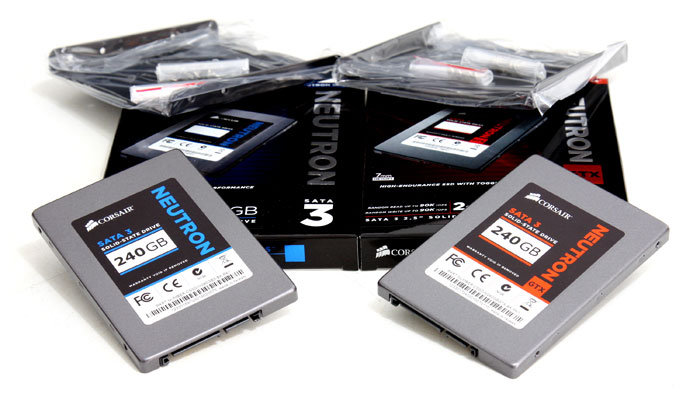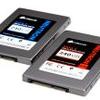Final words and conclusion
Final words and conclusion
Releasing successful SSD series is something Corsair is very keen on. Their enthusiast SATA3 segment is now certainly filled up with many SSDs, and each and every one of them is impressive.
Honestly I didn't expect too much of the Neutron series with that fairly unknown controller. Admittedly, it seems to be rock solid when it comes to performance. Now there is a clear and distinct difference though in-between the regular Neutron and the Neutron GTX model, I mean the GTX version simply writes a whole lot faster thanks to toggle NAND memory ICs. You do pay a 50 USD/EUR premium for that. Realistically the 'regular' Neutron model seems a little slower just because we compare it to its faster brother. But think about it for a second, the 'slow' model still writes at roughly 365 MB/sec according to our measurement. And that's still freaskishly fast for an SSD intended for you, the consumer.
But admittedly, the GTX definitely is sexy.
The good news is that seen overall the Neutron series is a winner as the drives perform well in all generic conditions, sustained, compressed, uncompressed and so on. The Neutron however was a little slower in some areas in trace based tests. But again, it's all compared to the fastest... realistically though it gets close, the SandForce 2281 series based products still win in overall performance. However, would you ever notice the difference in real-world usage? We doubt that very much. And we also know that many get spontaneous digestion problems when they hear SandForce these days.
Where the Neutron SSD series shines though is pure and brutal IOPS performance, our IOmeter test scored 85.000 IOPS... with both drives easily at 4K aligned files per second. That really is impressive as it means the In/Out throughput of this SSD can take a serious beating. So this SSD is just extremely fast when it has to deal with lots and lots of files simultaneously.

An SSD is enjoyable, very much so. If you put a drive like this into your SATA 3 compatible laptop or SATA 3 compatible PC, you'll have no idea what is about to hit you.
SATA ControllersSome overall recommendations then. Should you be in the market for a SATA 3 SSD then we have a couple of hints though, we absolutely prefer the performance of the Intel Series 6 or 7 (H67/P67/Z68/X79/H77/Z77) integrated SATA 6G controller over anything else available on the market. If you run an AMD chipset with the added Marvell 6G controller for example, you will see lower performance.
The new Asmedia controllers we spotted lately on motherboards are also offering good performance, albeit still 20%~25% slower than Intel's controllers. Also make sure you run your drive in AHCI mode, it does make such a difference in performance -- really guys, a big difference.
Prices -- HDD versus SSD
My advice is simple and I'll keep repeating this in each and every SSD conclusion; you probably should stop looking at the Solid State Disk technology as if it were a traditional HDD. We all will be old and grey before the two reach the same prices or top the multiple TB volume storage the HDD offers for less money. Comparing an SSD with an HDD is making a comparison in-between an integrated IGP or a dedicated graphics card, that last one will cost you a heck of a lot more yet you gain incredible overall performance. It is the very same with an SSD, use it as a boot drive for Windows and applications and you instantly have removed a huge bottleneck, namely load and access times. It is a night and day difference (in a proper system). For massive storage like movies, MP3 files and bulky data you do not access on a regular basis, sure, that's where the HDD remains the winner as a cheaper storage solution.
The magic simply is finding a good combination in-between the two and balance things out. That's where the magic happens. I kid you not, all my test systems and work systems run on SSDs, not once have I considered going back to HDDs. The benefits of a good SSD are simply grand. But that doesn't mean I do not understand the budget and cost dilemma that many of you are facing though. There are still many variables and unknowns regarding life-span.
Concluding
The Corsair Neutron Series as tested today is a fast and high performing product, the saturated market however is extremely competitive with lots of models and choices available.
We have very little to complain about the LAMD, it really performs way above what I initially expected. Then again, compared to a SandForce 2281 product like the Force GS is, it will lose a tiny bit of its edge. But merely in measured performance. Real-world performance simply hauls ass on these SSDs.
The IOPS performance on both drives was extraordinary fast, the read performance excellent, the sustained write performance very good as well. The trace benchmarks which we consider to be the most important, were good but not excellent. Overall, everything combined the Corsair Neutron is impressive to observe.
The GTX model comes with Toggle NAND flash memory, at a small price premium it really does make a difference when you focus on write performance and sure, the IOPS performance was a notch better as well.
We very much welcome a product with yet another controller on the market, in the end more players equals more competition. And that drives technology evolution upwards and prices down. We can't say anything about reliability really, as the LAMD LM87800 products are simply too new. However I have been using this SSD in my work rig for two weeks now and am very savvy with it.
The Neutron series as such comes really recommended for the storage performance mongers amongst you. The GTX just offers really strong performance in hefty workloads, has seriously good large-block sequential and random write speeds. Impressive is the word that sticks in my mind. But either one of these SSDs inside your PC is going to be an awe-inspiring experience. But the GTX .. roaaar !
- Leave/read comments on this product
- Sign up to receive a notice when we publish a new article
- Or go back to Guru3D's front page

